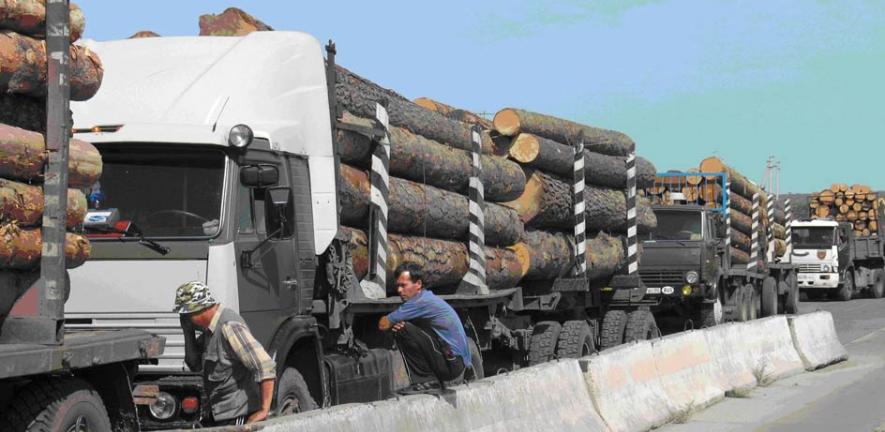
How two ‘rising powers’ – China and Russia – interact across the border they share with resource-rich Mongolia is the focus of a network led by the Mongolia and Inner Asia Studies Unit, as the researchers involved explain.
How two ‘rising powers’ – China and Russia – interact across the border they share with resource-rich Mongolia is the focus of a network led by the Mongolia and Inner Asia Studies Unit, as the researchers involved explain.
Global uncertainties are at issue in this region.
As rising economic and political powers, China and Russia often attract attention in relation to the West, but their interactions with one another, and comparisons between them, are less understood. Yet the two powers share thousands of miles of border, with the country of independent Mongolia lodged in-between them in the central part of the long frontier.
Our multidisciplinary project, based in the Mongolia and Inner Asia Studies Unit (MIASU), has for the first time brought together international discussion on the theme of the border economies of the three countries.
Over the course of the past year, with funding from the Economic and Social Research Council, the network has provided a unique opportunity for social scientists from Russia, China and Mongolia to meet with their counterparts in the UK at two workshops and through an online network. And to maintain collaboration among the physically dispersed scholars, a virtual experimental and empirical research environment – a ‘collaboratory’ – has been built, in which researchers can share research and ideas and, ultimately, trace the cross-border trajectories taken by people, goods and ideas.
Global relevance
Global uncertainties are at issue in this region: China’s search for energy resources and the employment of its huge population; Russia’s fear of Han infiltration of its Siberian expanses; and the precarious independence of Mongolia as both neighbours negotiate to obtain rights to extract resources there.
Greater knowledge is needed on how the changing socioeconomic conditions of neighbouring states affect migration flows between China and Russia, as well as the different citizenship regimes that are practically operative between the three countries.
Deeper understanding is also needed about conflicts of interest – in cross-border practices, local governments and central state policies – and what the reality is of Chinese expansion into Siberia and Mongolia. With international ventures, such as oil or gas pipelines, or uranium mines, it is important to establish what the local reactions are and what implications such ventures have for environmental policies.
An in-depth analysis of these dynamics requires not only the kinds of accounts provided by political science and economics, but also the information and insights that anthropology can furnish. The rationale for this project lies in the lack of accessible and reliable accounts of the practical workings of the Chinese and Russian states, especially in minority-inhabited regions such as those along the frontier. Where new information about the situation on the ground does exist, much of it is ongoing and unpublished, or is buried in local publications and published in languages that are difficult for all to access.
If Russia and China are to be properly understood, both by scholars and policy makers based in the West and by those of the countries concerned, there is a need to collect, translate and disseminate this research and to analyse it comparatively.
Frontier knowledge
The frontier zone linking China and Russia with eastern Mongolia is a region where MIASU has built strong links, engaging in policy debate as well as academic research. Although this 4,400-mile border is not an area of global economic advertisement for either country, it is a significant region for strategic policy.
Already, findings from the network are identifying how these hinterlands out of the public eye can tell us much about emergent processes of economic and political governance, through analysis of the practical operations of these post-imperial states.
For instance, two ongoing, and so far little-studied, regional processes are likely to be particularly illuminating. Russia has a policy of amalgamating small, ethnically defined territories into larger units with Moscow-appointed leadership. And China has a policy of relocating herding populations, almost all of which are from ethnic minorities, and closing pastures for purposes of environmental protection. Each of these policies may be compared with parallel, but different, solutions to problems of governance and environment on the other side of the border.
Such comparison is aided by the fact that the main indigenous population of the studied frontier zone consists of one ethnic group, the Buryat, a people of Mongolian origin. The two above-mentioned administrative decisions have aroused considerable anxiety for the Buryat and other local people. Work has begun through the network to assess existing information on the forms of protest and compliance found, and the effects on migration and trade.
The inclusion of Mongolia in the network is also significant because it allows us to explore how Russia and China attempt to include such countries in their sphere of interest. Mongolia is resource-rich but underdeveloped, and a prominent object of resource extraction for both China and Russia.
This study allows us to examine processes of infrastructure construction and resource extraction that are comparable with Chinese and Russian ventures elsewhere in the world. It also enables us to investigate what particular consequences Russia and China’s rise might have for future regional divisions of labour, and for examining the social consequences of economic adjustment within Mongolian society.
Zones of uncertainty
Both Russia and China like to imagine themselves as centralised, vertically organised states that control all of the territories up to their borders. Yet, distant hinterlands remain zones of uncertainty, where there may be a potentially flammable mix of anxieties surrounding the extraction of valuable resources and mobile ethnic populations.
Recent anthropological research by MIASU members on the topic has shown that another phenomenon is to be added to the mix: laterally organised, informal, partially legal, local economies operate to some degree in opposition to central state policy and make their profits precisely because of the existence of the border.
One example is illegal salmon fishing and fish trade in the Amur River (the border), where ethnographers have shown the existence of networks of poachers and phoney companies linked across the border. The Siberian–Chinese–Mongolian frontier is alive with ‘transmigrants’, guestworkers, joint ventures, smuggling, mediators, shuttle-traders, illegal work gangs and fictitious companies.
Our discussions of the real situation on the border are addressing policy stakeholder’s concerns, such as poverty and survival strategies, transparency and social adjustment. The relation of this burgeoning frontier economy to more formal ventures, such as the Russia–China gas pipeline, Russian mining in Mongolia, or Chinese railways in Mongolia, as well as to potential ethnic conflict, will also be investigated, especially given that the same conditions do not apply everywhere.
But our end goal will be to contribute some answers to questions of global significance: is China expanding, and if so, how? And how do China and Russia actually govern their frontier provinces and potential disturbances therein?
For more information, please contact Professor Caroline Humphrey (ch10001@cam.ac.uk), Dr Gregory Delaplace (gd307@cam.ac.uk) and Dr Franck Billé (franck.bille AT gmail.com) at the Mongolia and Inner Asia Studies Unit (http://innerasiaresearch.org/).
This work is licensed under a Creative Commons Licence. If you use this content on your site please link back to this page.





